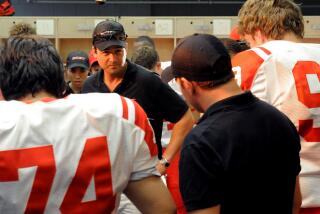Threads of Time : A display of brightly colored textiles at CSUN art gallery offers insight to the tribal cultures of Thailand and Laos.
Throughout time, textiles have told us stories about the people and the cultures that have produced them.
“By threads, we are connected to the major events of our lives,” said Sheila Allen-Weiss, curator of the Cal State Northridge Art Gallery’s exhibit, “The Connective Thread: Textiles of Thailand and Laos.”
“In the West, we go from swaddling clothes to christening gown, confirmation dress, prom dress, wedding gown and eventually a funeral shroud,” she said. “In the East, and more specifically, Southeast Asia, the textiles worn connect one to more than major events. A woven stripe, a change of color or variation of pattern can signify tribal affiliation or a change of allegiance.
“A style of woven turban or skirt cloth can define one’s social status, subgroup links, wealth or importance and even age level. You can’t be what you’re not. You have to be what you are.”
The show presents 50 intricate, often brightly colored textiles representing about 20 tribes that live in remote villages in the foothills and mountains of Northeast Thailand and Laos. All the pieces are 20th-Century. Most of them are completely handmade. They come primarily from the collection of Dr. Raymond Briggs of South Pasadena, with additional pieces on loan from other Southern California collections.
“I selected the best example of what I could get--the oldest, the most complex, the most well-made,” said Allen-Weiss, who studied textiles in China for six months and is working on a master’s degree in Asian textiles at CSUN.
Art gallery director Louise Lewis, who said she loves textiles, noted they “have long displayed issues of design, pattern, conceptualization and composition. All the issues that are at stake in modern painting have been addressed for centuries, if not millennia, in textiles.”
She was particularly receptive to bringing this exhibit to the gallery to “draw from the surrounding community such a distinguished collection, and from the campus, our own distinguished researcher on the subject. We found her historical academic research background as well as her aesthetic sensibilities to be an ideal match for the show.”
Allen-Weiss has divided the show into two sections: One displays objects from daily life such as hats, shoulder bags and shawls. The other contains the banners, meditation squares and burial clothes used in rituals and religion.
Methods of production have changed little since ancient times.
“Textile production is primarily in the hands of women,” she said, adding that they also grow the raw materials. Girls begin to learn embroidery at about age 6. “The width of the loom determines the width of the textiles. There are many different motifs--floral, vegetal, animism, Buddhist. In early times, Buddha was represented as a geometric pattern--the Buddhist eye--rather than the figure. The elephant foot (signifies) great virtue and great fortune.”
The meanings of some of the symbols in modern pieces have been lost, but contemporary weavers continue to use them in their work.
*
Allen-Weiss described herself as “a weaver and spinner and generally a textile person. I’ve embroidered since I was a child.” Her fascination with Southeast Asian textiles grew out of her being “intrigued as hell by Chinese Buddhist textiles. They are done for the purpose of going to the temple and gaining merit. . . . I have a great admiration for their complexity of weaving and embroidery. They give their very best work to the temple. It’s a thorough integration of textile with religion.”
Allen-Weiss sees “quite strong links” in the textiles of China and those of Southeast Asian tribes, she said. Several of the tribes established in Southeast Asia moved there after being forced out of China.
This exhibit is “a chance for people to see items they won’t normally see,” she said. “There’s been little emphasis on hill tribes, and I think they deserve a major emphasis. Their traditions are being fast lost as they have more interaction with towns and tourists.
“In the towns, you see a disintegration of the culture and a loss of technique. Plastic buttons instead of shell. Aniline dyes are taking the place of indigo and vegetable dyes. Some of (the weavers) are getting sewing machines.”
Looking over the fine, hand-made objects in the show, she said, “You won’t see these things much longer.”
Where and When
What: “The Connective Thread: Textiles of Thailand and Laos.”
Location: CSUN Art Gallery, Art Annex 116 (a trailer near Nordhoff Street and Etiwanda Avenue), Northridge.
Hours: Noon to 4 p.m. Mondays, 10 a.m. to 4 p.m. Tuesdays through Fridays. Ends Nov. 18.
Call: (818) 885-2226.
More to Read
The biggest entertainment stories
Get our big stories about Hollywood, film, television, music, arts, culture and more right in your inbox as soon as they publish.
You may occasionally receive promotional content from the Los Angeles Times.






